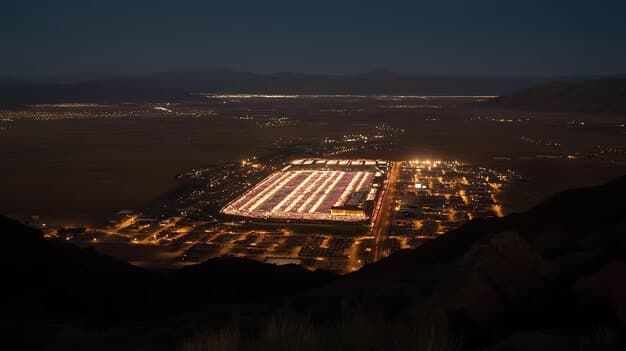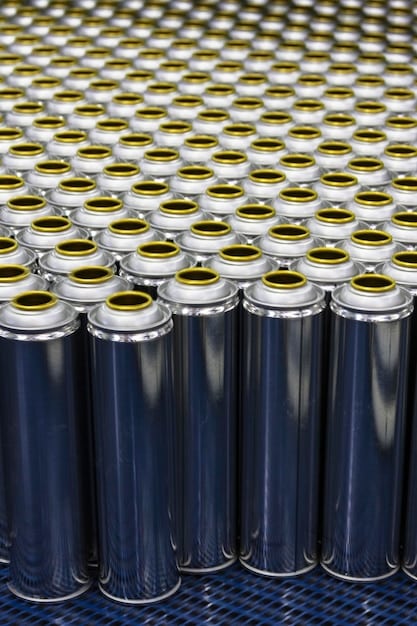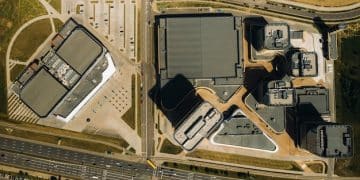US Battery Gigafactory Aims for 1 Million EVs Annually: News

A new US battery gigafactory is set to revolutionize the electric vehicle (EV) market by producing enough batteries to power 1 million electric vehicles annually, marking a significant step towards sustainable transportation and energy independence.
Exciting electric vehicle battery production news emerges from the US as a new battery gigafactory aims to produce enough batteries for 1 million electric vehicles annually, signaling a major leap in domestic battery manufacturing. This development promises to accelerate the transition to EVs and reduce reliance on foreign battery suppliers.
The Dawn of a New Era in US Battery Production
The electric vehicle (EV) industry is rapidly expanding, and with it, the demand for high-quality, reliable batteries. A new US battery gigafactory is stepping up to meet this challenge, aiming to produce enough batteries each year to power a million electric vehicles. This monumental project signifies a pivotal shift towards bolstering domestic battery production capabilities.
Boosting Domestic Battery Manufacturing
For years, the US has lagged behind countries like China and South Korea in battery manufacturing. The establishment of this new gigafactory represents a strategic effort to close this gap, ensuring a more secure and resilient supply chain for electric vehicles. This move aims to reduce dependence on foreign imports and foster job creation within the US.
Impact on the Electric Vehicle Market
The increased battery production capacity will have a profound impact on the EV market. By providing a stable and substantial supply of batteries, the gigafactory will contribute to lower battery costs, making electric vehicles more affordable and accessible to a wider range of consumers. This, in turn, will accelerate the adoption of EVs and support the transition to a cleaner, more sustainable transportation system.
- Reduces reliance on foreign battery suppliers.
- Lowers battery costs for EV manufacturers.
- Accelerates the adoption of electric vehicles nationwide.
- Creates numerous job opportunities in the US.
In conclusion, the arrival of a new battery gigafactory marks a significant turning point for the US electric vehicle industry. It promises to boost domestic battery manufacturing, reduce costs, and accelerate the adoption of EVs, paving the way for a more sustainable and economically secure future.
Gigafactory Location and Scale
One of the key details surrounding this exciting news is the physical presence of this new battery production facility. The location and scale of the gigafactory are critical factors influencing its potential impact. Strategic site selection and a massive production scale are essential for achieving the ambitious goal of powering one million EVs annually.
Strategic Location Benefits
Choosing the right location for a gigafactory involves considering factors like proximity to raw material sources, transportation infrastructure, and skilled labor pools. A strategically located gigafactory can minimize transportation costs, streamline logistics, and enhance overall operational efficiency.
Massive Production Capacity
To achieve the target of supplying batteries for one million electric vehicles each year, the gigafactory must operate on a massive scale. This involves investing in advanced manufacturing technologies, optimizing production processes, and ensuring a reliable supply of raw materials. The sheer scale of this operation will make it a major player in the global battery market.

- Strategic location minimizes transportation costs.
- Massive production capacity meets high battery demand.
- Advanced technologies ensure efficiency and quality.
- Scalability allows for future expansion.
In summary, the location and scale of the new US battery gigafactory are critical to its success. A strategic location and massive production capacity will enable the facility to efficiently produce high-quality batteries at a competitive cost, driving the growth of the electric vehicle market.
Advanced Technologies and Manufacturing Processes
The success of any battery gigafactory hinges on its ability to leverage advanced technologies and efficient manufacturing processes. Cutting-edge innovations can significantly improve battery performance, reduce production costs, and enhance overall sustainability. Implementing these advancements is vital for staying competitive in the rapidly evolving EV battery market.
Automation and Robotics
Automation and robotics play a crucial role in modern battery manufacturing. Automated systems can perform repetitive tasks with greater speed and precision than human workers, leading to increased productivity and reduced error rates. Robots are also used to handle hazardous materials and perform tasks that would be difficult or dangerous for humans.
Quality Control Measures
Maintaining high quality standards is essential for ensuring the reliability and longevity of EV batteries. Gigafactories implement rigorous quality control measures throughout the manufacturing process, from raw material inspection to final product testing. These measures help to identify and eliminate defects, ensuring that only the highest quality batteries reach the market.
Advanced technologies such as artificial intelligence, machine learning, and data analytics are also used to optimize manufacturing processes and improve battery performance. By analyzing data from various sensors and systems, manufacturers can identify trends, predict potential problems, and make adjustments to improve efficiency and quality.
- Automated systems increase speed and precision.
- Robots handle hazardous materials safely.
- Rigorous quality control ensures battery reliability.
- Data analytics optimize manufacturing processes.
In conclusion, the integration of advanced technologies and optimized manufacturing processes is crucial for the success of the new US battery gigafactory. These advancements will enable the facility to produce high-quality, reliable batteries at a competitive cost, supporting the growth of the electric vehicle market and fostering a more sustainable future.
Raw Materials and Supply Chain Management
The production of electric vehicle batteries requires a wide range of raw materials, including lithium, nickel, cobalt, and graphite. Securing a reliable and sustainable supply of these materials is essential for ensuring the long-term viability of the gigafactory. Effective supply chain management is therefore a critical component of the operation.
Sourcing Raw Materials Responsibly
Many of the raw materials used in battery production are sourced from regions with complex environmental and social challenges. It is therefore essential for gigafactories to adopt responsible sourcing practices, ensuring that materials are obtained in an ethical and sustainable manner. This may involve working with suppliers who adhere to strict environmental and labor standards, as well as investing in recycling and recovery programs to reduce reliance on virgin materials.
Building a Robust Supply Chain
A robust supply chain is one that is diversified, resilient, and transparent. Diversifying the supply base reduces reliance on any single supplier, minimizing the risk of disruptions due to geopolitical events, natural disasters, or other unforeseen circumstances. Building strong relationships with suppliers and investing in real-time visibility tools can also help to improve supply chain resilience.

- Responsible sourcing ensures ethical and sustainable material acquisition.
- Diversified supply base minimizes risk of disruptions.
- Strong supplier relationships improve resilience.
- Recycling programs reduce reliance on virgin materials.
In summary, effective raw materials and supply chain management are essential for the long-term success of the US battery gigafactory. By sourcing materials responsibly and building a robust supply chain, the facility can ensure a reliable and sustainable supply of the resources needed to produce high-quality EV batteries.
Economic Impact and Job Creation
The establishment of a new battery gigafactory in the US is expected to have a significant positive impact on the economy. In addition to boosting domestic battery production, the factory will create numerous job opportunities and stimulate economic growth in the surrounding communities.
Creating High-Paying Jobs
The gigafactory will require a large workforce of skilled technicians, engineers, and operators. Many of these jobs will be high-paying positions with opportunities for advancement. The availability of these jobs can help to attract and retain talent in the local area, boosting the regional economy.
Stimulating Economic Growth
In addition to direct job creation, the gigafactory will also stimulate economic growth by supporting local businesses and attracting additional investment. Local suppliers will benefit from increased demand for their products and services, and the presence of the factory may encourage other companies to establish operations in the area.
Furthermore, the increased availability of domestically produced batteries will support the growth of the electric vehicle industry, creating even more jobs and economic opportunities throughout the supply chain.
- Creates numerous high-paying jobs for skilled workers.
- Stimulates economic growth by supporting local businesses.
- Attracts additional investment to the region.
- Supports the growth of the electric vehicle industry.
In conclusion, the new US battery gigafactory is poised to deliver a substantial economic boost, creating jobs and stimulating growth in the surrounding communities. This development underscores the importance of investing in clean energy technologies and building a sustainable future.
Future Prospects and Expansion Plans
Looking ahead, the new US battery gigafactory has the potential to play an even larger role in the electric vehicle market. With increasing demand for EVs and ongoing advancements in battery technology, the factory is well-positioned for future growth and expansion. Its long-term success will depend on continued innovation, strategic investments, and a commitment to sustainability.
Adapting to Technological Advancements
The battery technology landscape is constantly evolving, with new materials, designs, and manufacturing processes emerging all the time. To stay competitive, the gigafactory must be able to adapt to these advancements, investing in research and development and upgrading its production lines as needed. This will ensure that the factory remains at the forefront of battery technology and can continue to produce high-performance batteries for the next generation of electric vehicles.
Long-Term Sustainability Goals
Sustainability is a growing concern for consumers and policymakers alike. To meet these demands, the gigafactory should prioritize long-term sustainability goals, such as reducing its carbon footprint, minimizing waste, and promoting the responsible sourcing of raw materials. This will not only help to protect the environment but also enhance the factory’s reputation and appeal to environmentally conscious customers.
- Adaptability to technological advancements ensures competitiveness.
- Strategic investments drive innovation and growth.
- Commitment to sustainability enhances reputation and appeal.
- Expansion plans accommodate increasing demand for EVs.
In summary, the future prospects for the new US battery gigafactory are bright. By adapting to technological advancements, prioritizing sustainability, and strategically planning for expansion, the factory can play a leading role in the electric vehicle market for years to come, contributing to a cleaner, more sustainable future.
| Key Point | Brief Description |
|---|---|
| 🔋 Battery Output | Produces enough batteries for 1 million EVs annually. |
| 🏭 Location & Scale | Strategically located for raw material access; massive production scale. |
| 🤖 Advanced Tech | Utilizes automation, robotics, and AI for efficiency and quality. |
| 🌎 Sustainability | Focuses on responsible sourcing and reducing carbon footprint. |
FAQ
▼
The gigafactory aims to produce enough batteries to power 1 million electric vehicles annually, making it a significant player in the EV battery market.
▼
The specific location details are often confidential, but it’s strategically situated in the US for easy access to raw materials and key markets.
▼
The gigafactory employs cutting-edge tech like automation, robotics, and AI to optimize manufacturing and ensure high-quality battery production.
▼
It prioritizes responsible sourcing of raw materials, adhering to environmental and labor standards to ensure ethical practices.
▼
The gigafactory focuses on reducing its carbon footprint, minimizing waste, and promoting responsible material sourcing for a sustainable impact.
Conclusion
The emergence of this new US battery gigafactory marks a pivotal moment for the electric vehicle industry. By aiming to produce enough batteries for 1 million EVs annually, it not only addresses the growing demand for sustainable transportation but also strengthens domestic manufacturing capabilities, reduces reliance on foreign suppliers, and sets the stage for a cleaner, more electrified future.





